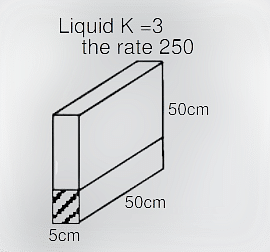
Find the equivalent capacitance across points A and B in the given electric circuit.

Find the equivalent capacitance across points A and B in the given electric circuit.
\(\frac{C}{2}\)
- 2C
\(\frac{5C}{3}\)
\(\frac{3C}{4}\)
The Correct Option is B
Solution and Explanation
The correct option is (B): 2C
Two capacitors will get short-circuited also,

\(C_{AB}=2C\)
Top Questions on Combination of capacitors
- As shown in the figure, two parallel plate capacitors having equal plate area of 200 cm2 are joined in such a way that a ≠ b. The equivalent capacitance of the combination is x ∈0 F. The value of x is_____.

- JEE Main - 2023
- Physics
- Combination of capacitors
- A parallel plate capacitor has plate area $40\, cm ^2$ and plates separation $2\, mm$ The space between the plates is filled with a dielectric medium of a thickness $1 \,mm$ and dielectric constant $5$ The capacitance of the system is :
- JEE Main - 2023
- Physics
- Combination of capacitors
- In the circuit shown in the figure, the capacitor is initially uncharged and the key K is initially open in this condition, a current of 1 A flows through the 1 Ω resistor. The key is closed at a time t=t0. Choose the correct options(given \(e^{-1}=0.36\))
- JEE Advanced - 2023
- Physics
- Combination of capacitors
- The liquid is raising at a rate of 250\(cm^3s^{-1}\) in the container. Value of the capacitance of the container after 10 sec.? (\(\varepsilon_0=9 \times10^{12}C^2N^{-1}m^{-2}\))

- JEE Advanced - 2023
- Physics
- Combination of capacitors
- A capacitor C1 of capacitance 5 μF is charged to a potential of 30 V using a battery. The battery is then removed and the charged capacitor is connected to an uncharged capacitor C2 of capacitance 10 μF as shown in figure. When the switch is closed charge flows between the capacitors. At equilibrium, the charge on the capacitor C2 is ____ μC.

- JEE Main - 2022
- Physics
- Combination of capacitors
Questions Asked in JEE Main exam
- Let \[\vec{a} = \hat{i} + \hat{j} + \hat{k}, \quad \vec{b} = -\hat{i} - 8\hat{j} + 2\hat{k}, \quad \text{and} \quad \vec{c} = 4\hat{i} + c_2\hat{j} + c_3\hat{k} \]be three vectors such that \[\vec{b} \times \vec{a} = \vec{c} \times \vec{a}.\]If the angle between the vector $\vec{c}$ and the vector $3\hat{i} + 4\hat{j} + \hat{k}$ is $\theta$, then the greatest integer less than or equal to $\tan^2 \theta$ is:
- JEE Main - 2024
- Vector Algebra
- 10 mL of gaseous hydrocarbon on combustion gives 40 mL of CO\(_2\)(g) and 50 mL of water vapour. The total number of carbon and hydrogen atoms in the hydrocarbon is ______ .
- JEE Main - 2024
- Hydrocarbons
- If each term of a geometric progression \( a_1, a_2, a_3, \dots \) with \( a_1 = \frac{1}{8} \) and \( a_2 \neq a_1 \), is the arithmetic mean of the next two terms and \( S_n = a_1 + a_2 + \dots + a_n \), then \( S_{20} - S_{18} \) is equal to
- JEE Main - 2024
- Arithmetic Mean
A body of mass 1000 kg is moving horizontally with a velocity of 6 m/s. If 200 kg extra mass is added, the final velocity (in m/s) is:
- JEE Main - 2024
- speed and velocity
- $\textbf{Choose the correct statements about the hydrides of group 15 elements.}$
A. The stability of the hydrides decreases in the order \(\text{NH}_3 > \text{PH}_3 > \text{AsH}_3 > \text{SbH}_3 > \text{BiH}_3\)
B. The reducing ability of the hydrides increases in the order \(\text{NH}_3 < \text{PH}_3 < \text{AsH}_3 < \text{SbH}_3 < \text{BiH}_3\)
C. Among the hydrides, \(\text{NH}_3\) is a strong reducing agent while \(\text{BiH}_3\) is a mild reducing agent.
D. The basicity of the hydrides increases in the order \(\text{NH}_3 < \text{PH}_3 < \text{AsH}_3 < \text{SbH}_3 < \text{BiH}_3\)
Choose the most appropriate from the option given below:- JEE Main - 2024
- p -Block Elements
Concepts Used:
Combination of Capacitors
The total capacitance of this equivalent single capacitor depends both on the individual capacitors and how they are connected. There are two simple and common types of connections, called series and parallel, for which we can easily calculate the total capacitance.
Read Also: Combination of Capacitors
Series capacitors
When one terminal of a capacitor is connected to the terminal of another capacitors , called series combination of capacitors.
Capacitors in Parallel
Capacitors can be connected in two types which are in series and in parallel. If capacitors are connected one after the other in the form of a chain then it is in series. In series, the capacitance is less.
When the capacitors are connected between two common points they are called to be connected in parallel.
When the plates are connected in parallel the size of the plates gets doubled, because of that the capacitance is doubled. So in a parallel combination of capacitors, we get more capacitance.
Read More: Types of Capacitors



